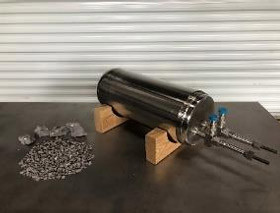
Protecting personnel, the public and the environment from radioactive materials requires an in-depth knowledge of design, fabrication, examination and testing, as well as application of the most stringent quality assurance programs. This knowledge is best gained from experience. From small, leak-tight containers for transporting medical isotopes, to large lead-shielded flasks weighing over 40-tonnes, Westinghouse has the knowledge and expertise to supply flasks and containers for a wide range of nuclear applications.
Westinghouse is best positioned to execute a new nuclear technology development, from design, licensing, plant startup and commissioning and ongoing technical support for plant operations.
Over the past 40 years, Westinghouse has designed and supplied several flasks and containers, each with features unique to individual customer needs. We have supplied a variety of leak-tight containers used to store and transport radioactive gases and liquids. These containers are designed to enable in-depth non-destructive examination (NDE) and highly sensitive testing (e.g. full radiography, mass spectrometer helium leak testing).
In some instances, shielding may be required and can consist of a combination of steel, lead, concrete, or in rare cases, depleted uranium. We have also designed, fabricated, and tested a large flask for on-site transport of spent fuel, with several inches of lead shielding and weighing over 82,000 lb.
Westinghouse has a range of capabilities in design and design reviews for manufact-urability. We design to reduce manufacturing risks, obtain repeatable product, and to reduce materials and building costs for our customers.

Immobilized Tritium Container (ITC)
Westinghouse has completed conceptual design studies for retrieval and re-packaging of waste currently stored in underground silos. The scope of one study included options for the safe retrieval of intermediate-level solid waste and analysis of potential deterioration of the storage containers. Another study was conducted to recommend solutions for shielded overpacks based upon the inventory of the various waste containers once they were safely retrieved. This scope included significant shielding design and calculations and making recommendations based on our experience with shielding design and fabrication.
Study scopes included:

Trusted Expertise
For inspection and documentation purposes, all waste packages must meet all acceptance criteria prior to disposal. Westinghouse has a long history of developing, delivering and using technologies and systems to qualify and analyze radioactive waste packages. The range of products Westinghouse offers includes fully automatic, segmented gamma scanning, X-ray scanning and equipment for gas sampling from waste packages.
It is possible to perform basic shielding calculations for simple configurations using longhand methods, however more complex problems can be solved using sophisticated computerized analysis. Westinghouse uses specialized software to perform detailed shielding analysis and to determine exposure rates. The type of source (point, surface, volume) and the applicable radioactive sources are modeled. The shielding thickness and configuration are also modeled, and the user can select from a database of conventional shielding materials or input their own custom material properties. The shielding material selected considers several factors, including suitability for the source of radiation, complexity of the final configuration, and ease of manufacturing. The user can determine, at various distances from the source, the exposure rates to personnel. These rates are compared to the customer’s acceptable dose rates, and adjustments to the shielding thickness are made to achieve the target dose limit. Also important to the shielding designer, the software can determine decay heat generated by the source, which can then be used in subsequent analyses.
The software can be used to estimate source strength from radiation measurements, an important tool when specific waste characterization data is not available. The software will also predict future makeup of sources based on source decay models and will forecast the resulting daughter products generated.
A design and build solution for peace of mind
Once a suitable shielding material and thickness is established, the designer must produce an acceptable design that satisfies the shielding requirements yet is able to be manufactured in accordance with conventional techniques to minimize cost and risk.
Our designers have a strong knowledge of how to design the product to minimize the risk of issues in manufacturing. The designer must consider potential shine paths and radiation scatter and provide suitable safeguards. They must apply their knowledge of manufacturing tolerances to ensure the shielding requirements will be achieved. Lead is commonly used, but to produce complex geometries the lead must be melted and poured into a steel shell. The designer must have in-depth knowledge of the process to design a suitable geometry to accommodate pouring molten lead without creating voids and significant shrinkage cracks, and the manufacturing drawings we generate need to ensure that the design requirements are realized. The Westinghouse design/build model is sought after by customers looking for a single contractor to design and fabricate turn-key equipment; thereby avoiding potential issues with responsibility should problems arise.
Once fabricated, it’s often necessary to verify shielding integrity using a method such as gamma scanning. It’s very difficult to repair issues with lead shielding once cooled and hardened, so design and manufacturing must ensure a quality product so there are no issues during this final check. Westinghouse has developed and applied a procedure for gamma scanning of thick shielding sections (in excess of 4 inches of lead) to determine shielding integrity with excellent success and good correlation with theoretical values.
Custom fabrication relies heavily on welded construction to produce complex geometries and leak-tight joints. Westinghouse is a recognized expert in the design, fabrication, and examination of welded joints. We’ve Developed and qualified many welding procedures in several processes and a wide range of materials, and we have the capability to perform a variety of inspection and testing.